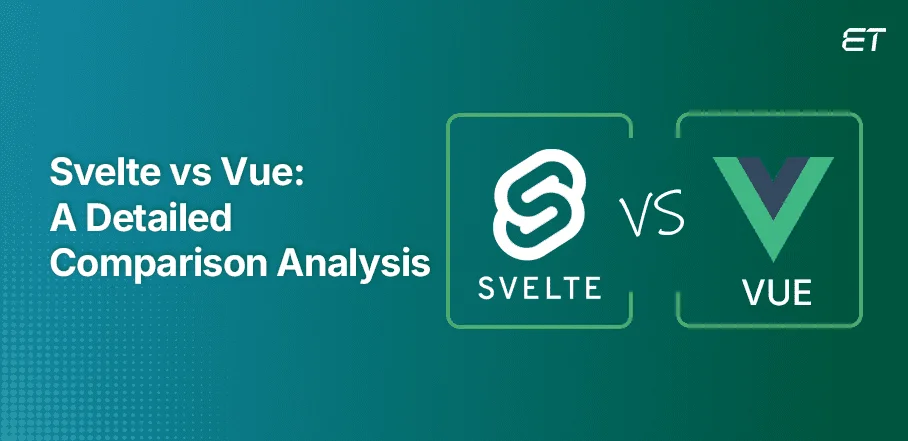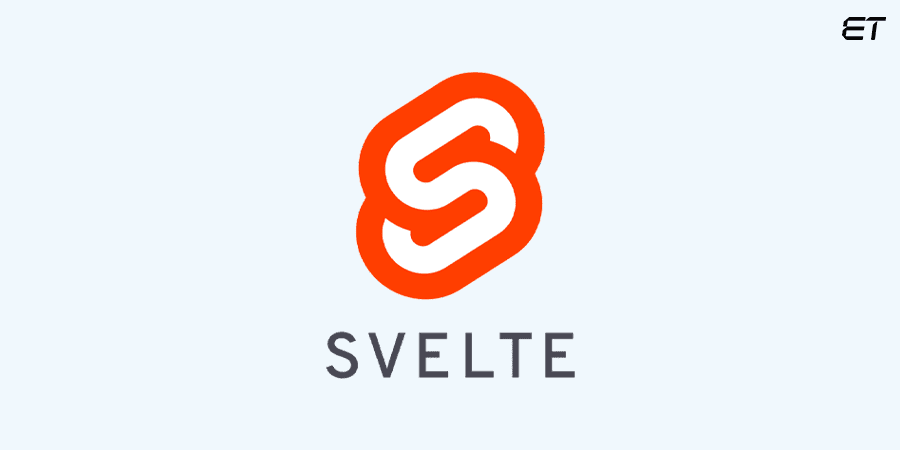
Svelte vs Vue: Best Frontend Framework Comparison
- Svelte and Vue are both modern JavaScript frameworks, but they differ fundamentally in architecture. Svelte compiles at build time, while Vue uses a virtual DOM at runtime.
- Svelte offers faster performance and smaller bundle sizes by converting code into highly optimized JavaScript during compilation.
- Vue provides a more mature ecosystem, with a gentle learning curve, powerful developer tools, and strong community support.
- You should choose Svelte if your priority is performance, reduced complexity, and minimal code overhead for smaller apps or MVPs.
- Opt for Vue if you’re building a scalable, maintainable application that may grow in complexity and benefit from extensive tooling and third-party integrations.
- The decision between Svelte and Vue should be based on your project’s size, complexity, team expertise, and long-term scalability needs.
Choosing the right frontend framework is like picking the perfect tool for a job — it can make or break your project’s success. Picking the right one, Svelte vs Vue, for your software can be confusing, but you must make the right choice as a decision-maker.
Your decision will influence your project’s efficiency, scalability, and overall performance. Both frameworks offer unique advantages that can significantly impact your business.
In this blog, we’ll compare Svelte vs Vue in detail, helping you understand which framework best aligns with your project needs and business goals. Whether you’re aiming for top-notch performance, ease of development, or long-term scalability, this guide is your go-to to make an informed decision.
So, want to make your next project a resounding success? If the answer is affirmative/Excited? let’s get started!
Brush up your knowledge and elevate your frontend game with our comprehensive guide!
What is Svelte?

Svelte is a relatively new but rapidly growing frontend framework that takes a unique approach by shifting much of the work to compile time rather than runtime. It aims to make web applications faster and smaller in size. Unlike traditional frameworks, Svelte compiles your code into highly efficient JavaScript at build time, resulting in a significantly reduced bundle size and faster performance.
Features of Svelte
Svelte stands out as a modern frontend framework that compiles code during the build time rather than relying on a virtual DOM at runtime. This approach enhances performance and provides a simplified development experience. Here are the key features that make Svelte a preferred choice for developers:
- Svelte uses no Virtual DOM. It compiles components into efficient JavaScript code at build time, ensuring faster performance.
- It automatically updates the UI when variables change, simplifying state management.
- Its component-based architecture encourages clean and reusable code with a modular structure.
- Its smaller bundle size produces minimal JavaScript bundles, leading to faster load times.
- Svelte requires fewer lines of code to create dynamic features, making development more efficient.
- Its built-in animations feature provides built-in support for transitions and animations with minimal configuration.
- It seamlessly integrates into TypeScript for better code safety and maintainability.
Pros and Cons of Svelte Framework
Let’s take a quick look at the pros and cons Svelte offers:
| Pros | Cons |
| Compiler-based, eliminates virtual DOM overhead, resulting in fast applications. | Smaller ecosystem compared to more established frameworks like Vue and React. |
| Intuitive syntax and reduced boilerplate makes it easy to learn and use. | Fewer libraries and plugins available. |
| Minimal runtime improves battery life and performance on mobile devices. | While active, the community is still growing, which might affect the availability of resources and solutions. |
What is Vue?

Vue is popular for its progressive design. It allows you to incrementally adopt features as needed, making it versatile for various projects. Vue uses a virtual DOM and focuses on the view layer, providing reactive data binding and a rich ecosystem of tools and libraries. It is designed to be approachable for beginners while providing advanced capabilities for experienced developers.
Features of Vue.js
Vue.js is a progressive JavaScript framework known for its simplicity, flexibility, and powerful tooling for building dynamic user interfaces. It combines the best features of modern frameworks like React and Angular while offering a gentle learning curve. Here are the standout features that make Vue.js a popular choice among developers:
- Vue optimizes rendering by updating only necessary parts of the Virtual DOM for better performance.
- It automatically synchronizes the UI and data model, ensuring real-time updates.
- Vue breaks the UI into reusable components, making development and maintenance easier.
- Its HTML-based templates with intuitive bindings make it easy to learn and use.
- Vue’s small size ensures fast loading and excellent performance.
- Tools like Vue CLI, Vue Router, and Vuex simplify development and project management.
- Vue can be integrated into existing projects or used for building single-page applications (SPAs).
- Its built-in animations feature support transitions and animations for dynamic user interfaces.
Pros and Cons of Vue Framework
| Pros | Cons |
| Mature and extensive ecosystem with a wide range of libraries, plugins, and tools. | Slightly less performant compared to Svelte due to virtual DOM. |
| Detailed and well-organized documentation with strong community support. | Can become complex and harder to manage in very large-scale applications without proper architecture. |
| Efficient virtual DOM and two-way data binding provide smooth and responsive user experiences. | Relies on a robust ecosystem of third-party libraries, which can lead to inconsistencies or reliance on external maintenance. |
Want to learn about the best practices to implement frontend security?
Svelte v/s Vue Comparison — A Head-to-Head Framework Comparison Table
Now that you have understood Svelte and Vue, let’s get to the most important part of this blog — a comparison analysis of Svelte vs Vue. This will help you understand the differences between the two and give you a clear idea of which to use for your application.
Before we discuss this in detail, take a look at the table below to get an overview of the differences:
| Aspect | Svelte | Vue |
| Performance |
|
|
| Development Approach |
|
|
| Learning Curve and Experience |
|
|
| Ecosystem and Community |
|
|
| Project Suitability |
|
|
| State Management |
|
|
| Component Lifecycle |
|
|
| Use Cases |
|
|
1. Performance
Svelte: Svelte’s compiler-based approach eliminates the overhead of a virtual DOM, making it incredibly fast. Compiling components to efficient JavaScript code at build time allows your Svelte applications to perform exceptionally well, even under heavy load. This makes Svelte an excellent choice for performance-critical applications. Additionally, Svelte’s minimal runtime means fewer resources are required, leading to improved battery life and performance on mobile devices.
Vue: Vue’s performance, on the other hand, is impressive, thanks to its optimized virtual DOM implementation. While it may not match the raw speed of Svelte, Vue strikes a balance between performance and ease of use. Vue’s reactivity system efficiently updates the DOM, ensuring smooth and responsive user experiences. For many applications, Vue’s performance is more than adequate. Moreover, Vue’s incremental adoption capability allows you to optimize performance progressively, making it suitable for evolving projects.
And the winner is – Svelte!
2. Development Approach
Svelte: It simplifies development by reducing the boilerplate code and focusing on a more intuitive syntax. You can write components in HTML, CSS, and JavaScript, which then compiles into highly efficient code. This approach results in faster load times and a smoother development experience. It further streamlines the development process by reducing the need for complex state management solutions.
Vue: The use of virtual DOM and two-way data binding makes Vue highly flexible and powerful. Its single-file components (SFCs) allow you to encapsulate HTML, CSS, and JavaScript in one file, streamlining the development process. This approach of Vue enhances maintainability and reusability, especially in large projects. Its extensive tooling, like Vue CLI and Vue DevTools, provides a powerful environment for building and debugging applications, further enhancing your productivity.
And the winner is – Svelte!
Are you struggling and confused about which framework to choose for your software? Don’t worry! You’ve come to the right place.
3. Learning Curve and Developer Experience
Svelte: Svelte is known for its straightforward and easy-to-learn syntax. If you’re familiar with basic HTML, CSS, and JavaScript, you can quickly get up to speed with Svelte. Its simplicity makes it an attractive option for smaller teams or projects with tight deadlines. Its clear and concise documentation, along with a growing number of tutorials and community resources, make it easier for you to adopt and master it.
Vue: Vue offers a gentle learning curve with comprehensive documentation and a supportive community. Its clear structure and logical design make it accessible to you irrespective of your skill level. Vue’s learning resources, like tutorials and forums, provide ample support for you to learn and get hands-on. If you’re familiar with React and Angular backgrounds, the transition will be smoother for you.
And the winner is – Svelte!
4. Ecosystem and Community Support
Svelte: While the Svelte ecosystem is still growing, it has made significant strides in recent years. The community is active and dedicated, with increasing libraries, plugins, and tools becoming available. SvelteKit, a framework for building web applications, has further expanded Svelte’s capabilities and ecosystem support. Therefore, its relatively young ecosystem is constantly evolving, promising future growth.
Vue: Vue, meanwhile, boasts a mature and extensive ecosystem with a wide range of libraries, plugins, and development tools. Its large and active community provides you with support and resources, making finding solutions and best practices easier. Its established ecosystem gives you a major advantage for your large-scale enterprise projects. The availability of frameworks like Nuxt.js for server-side rendering and VuePress for static site generation further enhances its versatility and adoption.
And the winner is – Vue!
5. Suitability for Different Project Types
Svelte: Svelte is suitable for performance-sensitive applications where load times and responsiveness are critical. It’s particularly well-suited for your small to medium-sized projects, static web apps, and mobile-first applications. Its simplicity and performance make it a strong choice if you are a startup or have a smaller development team. Additionally, Svelte’s ability to produce highly optimized code makes it a preferred option for your application if it has limited resources, such as embedded systems or IoT devices.
Vue: Vue excels in complex, large-scale applications requiring strong state management and a rich ecosystem of tools. It’s perfect for your single-page applications (SPAs), dynamic landing pages, and enterprise-level projects. It’s a preferable choice for you because of its flexibility and comprehensive toolset, which provides you with extensive development requirements. Its seamless integration with existing projects allows you to make incremental upgrades. It is suitable for legacy system modernization and the gradual adoption of modern frontend practices.
And the winner is – Vue!
6. State Management
Svelte: It offers you a simple and direct approach to state management using built-in stores. These stores provide you with a lightweight mechanism to manage state across components without needing a separate library. Svelte stores are reactive, meaning any change in the store’s state automatically updates all components that depend on it. This simplicity makes Svelte’s state management particularly suitable if your project or application is small and has a minimalistic approach. You can create writable, readable, and derived stores to manage different aspects of the application state effectively.
Vue: On the other hand, Vue provides you with a more structured state management solution with Vuex, a state management pattern and library for Vue applications. Vuex handles your complex state management in large applications by centralizing the state and providing you with a structured way to manage it through actions, mutations, and getters. This helps maintain a transparent and predictable state flow, which is essential for your large-scale applications with numerous components and interactions. Vuex integrates seamlessly with Vue’s reactivity system, making it a powerful tool for building maintainable state management solutions.
And the winner is – Vue!
7. Component Lifecycle
Svelte: Svelte simplifies the component lifecycle with fewer hooks and a more intuitive approach. They have a minimal set of lifecycle methods, such as onMount, onDestroy, and beforeUpdate, which cover the essential phases of a component’s lifecycle. This streamlined lifecycle management reduces complexity and makes it easier to understand and control your application’s component behavior. It focuses on the most critical lifecycle events, allowing you to quickly grasp and manage component states and updates.
Vue: Vue, meanwhile, offers a comprehensive set of lifecycle hooks that provide fine-grained control over your application’s component behavior. Its lifecycle methods, such as created, mounted, updated, and destroyed, allow you to tap into different stages of a component’s life and execute custom logic. This enables you to manage complex interactions and side effects efficiently. Vue’s detailed lifecycle hooks make it easier to manage state initialization, cleanup, and dynamic updates, providing a robust framework for building intricate and responsive applications.
And the winner is – Vue!
8. Use Cases
Svelte: Svelte is ideal for building lightweight, high-performance web applications where speed and smaller bundle sizes are crucial. It’s perfect for interactive widgets, dashboards, and static sites that need quick load times and minimal overhead. For instance, The New York Times uses Svelte for its interactive features, and Spotify’s Wrapped leverages Svelte for smooth, fast UI performance in data-heavy applications.
Vue.js: Vue is highly suited for building single-page applications (SPAs), dynamic user interfaces, and large-scale projects that require a rich ecosystem of tools and plugins. Its flexibility makes it a great choice for both small enhancements in existing projects and full-scale web apps. A great example is Alibaba, which uses Vue to enhance the user experience in its e-commerce platform. Additionally, GitLab uses Vue for building scalable, collaborative features in its project management tools.
When to Choose Svelte?
Svelte is an excellent choice if you’re aiming to build high-performance, lightweight web applications with minimal overhead. If your project demands fast load times, reduced bundle sizes, and an overall smooth experience, Svelte’s compiler-first approach gives you a significant edge.
Choose Svelte when:
- You want maximum performance with minimal code.
- You’re building a project with tight performance constraints, such as interactive dashboards, real-time interfaces, etc., where every byte counts.
- You prefer simplicity and clean syntax.
- You’re working with a small team or individual and want a framework that doesn’t require extensive configuration or external libraries.
- You want built-in animations and transitions without the hassle of relying on third-party solutions.
When to Choose Vue?
Vue is an ideal fit if you’re seeking a flexible, progressive framework that scales with your project’s complexity. Its approachable syntax, robust tooling, and supportive ecosystem make it suitable for everything from quick prototypes to enterprise applications.
Choose Vue when:
- You need a gentle learning curve.
- You’re building scalable single-page applications (SPAs).
- You need smooth integration with other technologies and a strong ecosystem.
- You want a maintainable, component-based architecture that helps organize code and supports long-term scalability.
- You’re working with a diverse team.
While we’re at it, you must be wondering what to choose between Svelte vs Vue after going through the details, right? Well, choosing between Svelte vs Vue depends on your specific project needs and organizational goals.
If you want performance-critical applications and have smaller teams, Svelte can be an excellent choice for you because of its speed and simplicity. On the other hand, if your project is large-scale and complex, Vue can be an ideal choice for you because of its flexibility, comprehensive ecosystem, and ease of use.
We hope this blog has given you a comprehensive insight into Svelte vs Vue so you can make an informed decision. If you have any queries or want assistance for your project, get in touch with our experts today. We look forward to helping you!
Frequently Asked Questions
1. What makes Svelte faster than Vue?
Svelte’s compiler-based approach makes it faster than Vue as it eliminates the need for a virtual DOM by converting components into highly efficient JavaScript at build time.
2. Is Vue better for large-scale projects compared to Svelte?
Yes, Vue is generally better suited for large-scale projects due to its extensive ecosystem, robust state management capabilities, and comprehensive tooling that supports complex application development.
3. Which framework is easier to learn for beginners — Svelte vs Vue?
Both frameworks are relatively easy to learn, but Svelte is slightly easier for you to learn if you’re a beginner as it has straightforward syntax and reduced boilerplate code.
4. How do Svelte and Vue handle reactivity differently?
Svelte uses a unique reactivity model where state changes are tracked at compile time, resulting in automatic and efficient updates. Vue uses a reactive data-binding system with a virtual DOM to manage state changes and update the UI efficiently.





